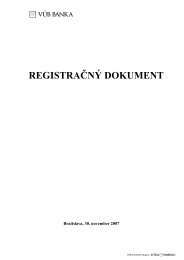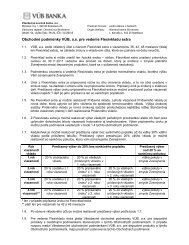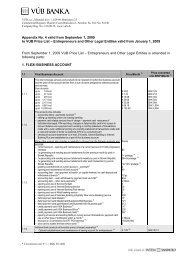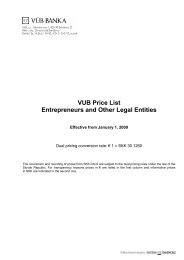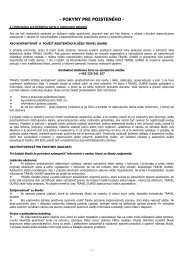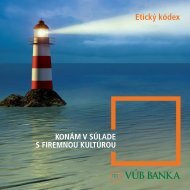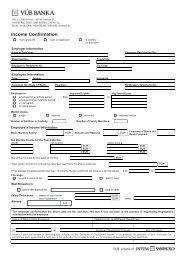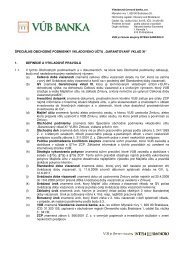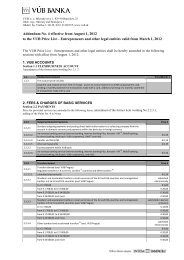Annual Report - VÃB banka
Annual Report - VÃB banka
Annual Report - VÃB banka
You also want an ePaper? Increase the reach of your titles
YUMPU automatically turns print PDFs into web optimized ePapers that Google loves.
Development of the External Environment<br />
In the year 2007, the Slovak economy has built<br />
upon the positive trends initiated in the previous<br />
year and posted its best performance ever. Indeed,<br />
increasing capacities and launched production<br />
in the export-oriented car and electronics manufacturing<br />
has pushed real GDP growth to close to<br />
ten percent from the previous all-time strong gain<br />
of eight and an half percent in 2006. This was the<br />
sixth consecutive year when Slovakia outgrew its<br />
Visegrad four neighbors. Importantly, growth of the<br />
Slovak economy was nearly four times higher than<br />
that of the Eurozone, which means that Slovakia<br />
has last year made yet another sizable step toward<br />
the Western European standards of living.<br />
Importantly, growth of the Slovak economy has not<br />
only been fast but also well balanced and broad<br />
based. Both foreign and domestic demand contributed<br />
positively to growth. The corporate sector<br />
saw profi ts increase by XX% over the already<br />
record-high levels of 2006, while households benefi<br />
ted from further decline in unemployment and<br />
meaningful income gains. Strong economic growth<br />
boosted also the fi nances of the public sector, allowing<br />
it to cut the overall fi scal defi cit to well below<br />
3% of GDP without foregoing increases in real public<br />
spending.<br />
Financial markets-wise, the year 2007 has been<br />
affected by two major events. The fi rst event was<br />
the revaluation of the koruna exchange rate parity<br />
within the ERMII on March 16. The new parity of<br />
35.4424 koruna vs. the euro was put 8.5% stronger<br />
than the original one of 38.4550 set upon Slovakia’s<br />
entry into the EMRII on November 25, 2005. In<br />
reaction, the koruna has fast appreciated to an all-<br />
-time strong level of 32.68 vs. the euro and, shortly<br />
after, the central bank has in two steps reduced<br />
the offi cial interest rates by cumulative 50bps. The<br />
second development affecting the Slovak fi nancial<br />
markets has been more of a global nature and emanated<br />
from the crisis on the US sub-prime mortgage<br />
market, which burst out in late summer. This<br />
crisis gradually spread out to involve broader credit<br />
markets, choking off liquidity and tightening credit<br />
conditions also in Europe. Besides, it dealt a blow<br />
to confi dence of investors and led to a massive increase<br />
in risk aversion, which affected also emerging<br />
markets of Central Europe, including Slovakia.<br />
In reaction, the koruna has basically stopped appreciating<br />
and broadly stabilized within a range until<br />
the beginning of 2008.<br />
Banking sector-wise, the local market continued to<br />
enjoy further expansion. Both the loan and the deposit<br />
market expanded strongly, having grown volumes<br />
by 24% and 13%, respectively. On the loan<br />
market, growth continued to be higher in the retail<br />
than in the corporate segment, but, compared to the<br />
previous years, the gap has narrowed, to 28% and<br />
22%, respectively. On the deposit market, growth<br />
was broadly even between the two segments. Besides,<br />
after a bad year 2006, the asset management<br />
business had resumed growing, posting over 20%<br />
expansion in volumes.<br />
2008 Macro Outlook<br />
The year 2008 will in many ways be a breaking one<br />
for Slovakia. If everything goes as planned, this year<br />
will be the last one for the koruna, which is scheduled<br />
to be replaced by the euro upon Slovakia’s entry<br />
into the Eurozone on January 1, 2009. Before adopting<br />
the single European currency, Slovakia has to<br />
fulfi ll the fi ve Maastricht criteria, which is seen very<br />
likely. Some discussion nonetheless remains about<br />
the sustainability of the criteria fulfi llment, which at<br />
the beginning of 2008 still leaves some probability<br />
that the euro adoption is postponed. In any case,<br />
the conditions on the Slovak fi nancial markets are<br />
already very similar to that of the Eurozone, with<br />
the key NBS’ 2-week repo rate being just 25 basis<br />
points above that of the ECB’s 4.00%.<br />
Economy-wise, the year 2008 is unlikely to produce<br />
yet another record-high GDP growth. Against the<br />
stalled output in the US and generally weakening<br />
EU economies, also the Slovak business confi dence<br />
has taken hit recently, with the overall economic<br />
sentiment indicator having declined at the beginning<br />
of 2008 back to its long-term trend. Still, at<br />
around 7%, GDP growth is projected to be healthy<br />
and strong relative to Slovakia’s neighbors and EU<br />
countries in general.<br />
7<br />
VUB, a bank of Intesa Sanpaolo group



